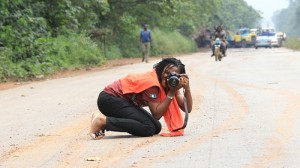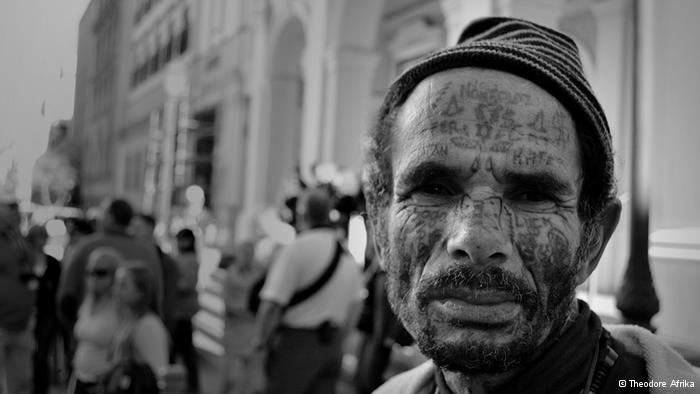Africa through the eyes of African photographers
 Africa is booming, economically and artistically. And riding on this boom are home-grown African photographers who are capturing alternative images of this rapidly-changing continent. If a picture tells a thousand words, then many photographs taken by Western photographers tell stories of grief and misery. From images of child soldiers brandishing weapons to sickeningly emaciated children, Africa is often portrayed as a continent of war, famine and poverty.
Africa is booming, economically and artistically. And riding on this boom are home-grown African photographers who are capturing alternative images of this rapidly-changing continent. If a picture tells a thousand words, then many photographs taken by Western photographers tell stories of grief and misery. From images of child soldiers brandishing weapons to sickeningly emaciated children, Africa is often portrayed as a continent of war, famine and poverty.
The rise of African photographers, however, is seeing other images emerge of a vibrant continent determined to express itself through its own images. Along with this is increasing recognition of the importance of supporting local photographers. Deutsche Welle, for example, has just awarded a new prize for human rights photography in Africa as part of the German Development Media Awards. One of the few African institutions dedicated solely to photography is the Market Photo Workshop based in Johannesburg. DW Akademie talked to Market Photo Workshop’s head, John Fleetwood, about the importance of photography in Africa, how the scene has changed in the past few decades and some of the challenges African photographers face.
Why was Market Photo Workshop set up as a dedicated photo training school?
It started in 1989, which in South African terms was quite a volatile period of political instability (at that time, popular protests against Apartheid were reaching their peak and the government had declared a national state of emergency that, among other things, completely restricted the press from covering political unrest). David Goldberg, a very famous South African photographer, together with friends of his, thought it was vital to set up some kind of photography institution to train young photographers who were disadvantaged by apartheid, who were not allowed into universities and who were struggling to get their foot in the door. The idea was mainly to allow young black photographers to gain entry to the market.
Why was encouraging photography so important back then?
There is a long history of misrepresentation in Africa. We have a long history of colonialist reporting to Europe instead of reporting to communities in the country. The Market Photo Workshop was set up to enable the voices of these communities to be heard, to allow people to tell stories which might be mundane but are very important collectively and start to paint a picture of the larger reality.
Is photography just as important now in Africa?
At the Photo Workshop, we still believe that we are living in a very unequal society and the only way to address that is to ensure proper ways of communication and to allow the voices of these people to be heard. I think the quest for democracy and understanding of what democracy is about has a long history in photography. Photography has always been about telling stories of your neighbourhood and of your community and through that, humanizing people around you and enabling people to understand and communicate. So photography is playing a critical role in the region.
Have you been successful in getting black photographers into the field?
There are very prominent young black photographers in South Africa that are able to find space for their photography. There are a lot of opportunities that have been created in the country and that is different to the rest of the region where photographers struggle to create space for themselves. For example, at The Star newspaper, which is one of South Africa’s most important dailies, 79 percent of their photographers are trained at the Photo Workshop and are black. This has helped readjust the understanding of what a photojournalist is. I also think that young black photographers are more competitive nowadays because of their accessibility to different communities, because of their language skills and their understanding of the culture.
Are these new group of photographers producing new images of Africa?
Gone are the times where photographers misrepresented Africa as a continent of poverty. Now, lots of photographers are able to photograph their surroundings and suddenly, we start to see that there is a a much more contemporary culture in Africa, and that has been in Africa for a long time. And although there is still a great deal of room for improvement, such images also show that some of Africa’s economies are working well and these are the ones the world can learn from.
Have you seen a big difference in the type of photos people are taking since Market Photography Workshop started up?
There has been a huge difference in the subject matter and it is interesting for me because as well as the enormous political changes in South Africa, there have also been large technical changes. This makes it hard to distinguish if it was the political environment or if it were the technical issues that have changed the way we looked at photography. But broadly speaking, I think there was a very strong moment towards questions around identity, where young photographers started to photograph themselves as part of the community and through that express their identity. When we first started, much of the photography was struggle photography – photographers used photos as a way of expressing their political values. Photography was seen as a way of destabilizing the state and a way of making sure the oppressed was heard. Distinguishing between a photographer and activist was almost impossible. Then people started to move away from photojournalism or documentary practice to different kinds of practice, such as playing with construction. So the definition of documentary photography has broadened quite a lot in South Africa. I think it was a time when galleries started to look at the arts as a way of creating a voice for the public and a lot of the photography that has gone to the galleries has shifted the understanding of photography.
Is photography growing in other parts of southern Africa as well?
At the moment you have some strong growing economies, particularly Angola and Mozambique where there is an emerging middle class and these people consume news. For that reason, one would assume that there will definitely be a growth in photojournalism in the next decade. In addition, there is this need to report on political issues, in countries such as Zimbabwe for example, that seems to be stabilizing after a lot of uncertainty. So I think there is a great interest in Africa in trying to develop young photographers.

Oluyinka Adeparusi won the African photography prize at the 2013 German Development Media Awards for this photo entitled ‘Where there is will, there is education’
What are some of the problems being faced by photographers in Africa?
The biggest problem we are facing is the lack of sustainability around many of the training projects. Apart from the Market Photo Workshop, I don’t know of other institution in the whole of the African continent that is a dedicated photography institution so photography training remains very very difficult. The Photo Workshop now has a quota to recruit at least a quarter of its students from outside of South Africa. But there are all kinds of conditions around issues such as medical insurance and visa requirements which makes it difficult for us to reach out to those people who do not have voices.
Are photographers limited to working for the media or are their other possibilities?
In South Africa, there is a minute gallery market but it exists. Galleries such as Goodman and Stevenson for example have been able to put on exhibitions of important young photographers. So there is the possibility of expressing themselves in this way. Galleries outside of South Africa are quite rare, and so very few photographers are making a living out of that. They tend to be employed in the media and online.
Any recommendations of photographers to look out for?
There are many many names with great talent. South African photographer, Zanele Muholi whose work is really exemplary of how photography can be used as a vehicle to drive questions around identity. She has photographed and continues to photography questions around lesbian and gay communities so she propagates understanding of these communities and I find her work extraordinary.
Tracy Edser is another South African who is very interesting. She has done a body of work on drug recovery and on hospitals and psychiatric units.
Jerry Gaegane is a South African photographer who is busy working on a project of surface mining which is an extraordinary project because the surface miners play a large part in central questions around what has happened in mining since democracy in South Africa.
Sammy Baloji from DRC has also done a beautiful body of work around mining and the memory of mining in the Congo.
Filipe Branquinho from Mozambique photographs people working in different occupations and has created a remarkable inventory of this.
Nyaba Ouedraogo from Burkino Faso has done some very beautuiful work on the memory of the Congo, looking in particular at the ideas of ritural and spirituality.
Interview: Kate Hairsine





Feedback